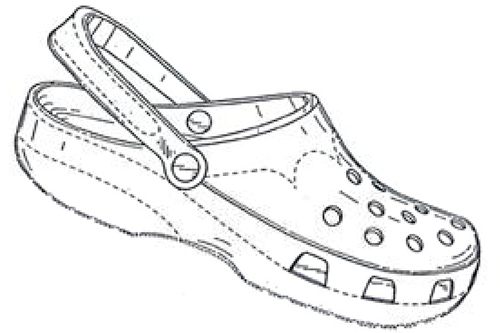CROCS EU design: risks of prior disclosure worldwide
The invalidation of the EU design for CROCS shoes highlights risks of prior disclosure worldwide. On 14 March 2018, the General Court of the ECJ upheld the 2010 decision of the Board of Appeal and the CROCS RCD is now invalid, notwithstanding arguments by the rights holder which sought to exclude the better evidence as being late filed and inadmissible.
In our book “European Design Law”, we highlight (on page 60 for those with a copy) the decision of the Board of Appeal in case R 9/2008-3, in March 2010, which concerned the registered Community design for CROCS shoes. A representation from the registration (Design number 002570001-0001 – the “CROCS RCD”) is depicted below:

In that decision, the Board of Appeal at the EUIPO declared the CROCS RCD invalid on the basis of prior disclosures by the design holder of CROCS products, inter alia at a nautical trade fair and on its website, more than 12 months before the CROCS RCD had been applied for (hence the grace period for the holder/design applicant could not apply). The Board of Appeal found that these disclosures made the design available to the public for the purposes of Articles 5 (novelty), 6 (individual character) and 7 (disclosure) of the Community Designs Regulation 2002 (the Regulation). Thus the CROCS RCD lacked novelty and individual character because it had, in effect, been prior disclosed by itself.
In so finding, the Board of Appeal rejected the design holder’s arguments that these disclosures could not reasonably have become known in the normal course of business to the circles specialised in the sector concerned, operating within the Community. This is the so-called obscure prior art provision in Article 7(1) of the Regulation.
The 2010 decision of the Board of Appeal was further appealed to the General Court at the ECJ but that appeal was withdrawn when, apparently, the invalidity action was withdrawn. The CROCS RCD therefore survived.
A further invalidity action against the CROCS RCD was, however, launched by a different entity in 2013, unsurprisingly perhaps relying on the same prior disclosures as had persuaded the Board of Appeal the first time. This invalidity proceeding failed at first instance before the Invalidity Division on what appears to have been something of a technicality (poor quality and/or undated exhibits). This was corrected on appeal, where better evidence was filed, and the CROCS RCD was again declared invalid by the Board of Appeal. On 14 March 2018, the General Court of the ECJ upheld the Board of Appeal and the CROCS RCD is now invalid, notwithstanding arguments by the rights holder which sought to exclude the better evidence as being late filed and inadmissible.
The General Court’s decision mirrors the decisions of the Board of Appeal both in 2016 and earlier in 2010. In short, the court found that where there is proof of prior disclosure anywhere in the world, the burden shifts to the rights holder to show that this could not reasonably have become known to the relevant circles in the Community. This is a question of fact. On the facts, which were that the design the subject of the CROCS RCD had been disclosed on the rights holder’s website, at a major nautical trade fair and through general sale in the US, the court held that the rights holder had not established these could not reasonably have become known…[etc]. The website was accessible worldwide, the trade fair was a major international event, and no evidence was adduced to rebut the necessary presumption in relation to widespread sales.
Conclusions
The key message to draw from this decision is to make sure that any RCD application is filed within the 12 month priority period extending from any public disclosure of a design by the applicant. The obscure prior art exception is likely to be very hard to establish in relation to a self-disclosure in particular. This is especially important if any EU design protection is desired, including unregistered Community design rights (UCDR). The latter point arises because under the Regulation, UCDR is only available if the first disclosure of a design occurs within the EU: if there is first disclosure outside the EU, no UCDR can arise because that first disclosure will be prior art against such rights (there is no grace period for UCDR). The upshot is that if no RCD filing is made within 12 months of a self-disclosure outside the EU, there can be no EU design protection at all. It may also be worth bearing in mind that after the UK leaves the EU, subject to transitional arrangements a first disclosure in the UK will have the same relevance for these purposes as one in, say, the US.